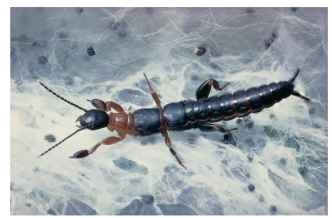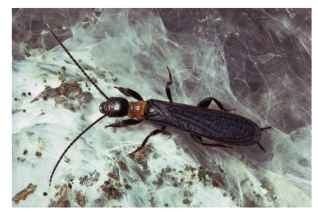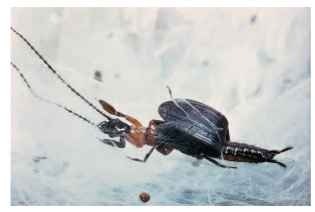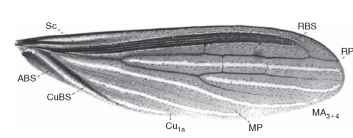Embiidina (Embioptera, “webspinners,” “foot spinners,” “embi-I—^ ids”) are warm-climate-adapted insects. Only about 300 spe-F * cies are named, but the order perhaps comprises about 2000 species. Embiids are perhaps most closely related to stone flies and stick insects (Phasmida) but, probably since Carboniferous or Permian times, have followed their own specialized evolutionary line. The most peculiar feature of all embiids, regardless of developmental stage or sex, is an ability to spin hundreds of strands of silk with each stroke of the greatly enlarged, gland-packed basal segment of the foretarsi.
The silk is formed into narrow galleries serving as protective runways in or on the food supply—weathered bark, lichens, moss, or leaf litter. In arid regions the galleries extend deep into soil and there serve as refuges from heat and desiccation. The primordial habitat is tropical forest, where predation-reducing galleries of most species radiate on edible surfaces of tree trunks. When disturbed, an embiid quickly darts backward into the depths of the labyrinth or into a crevice beneath such cover.
HABITS AND SPECIALIZATION
Except for short, hazardous dispersal of adults, embiids almost never leave the shelter of their self-created microenvironment, and most of the order’s anatomical and behavioral characteristics foster very smooth, rapid, reverse movement in narrow galleries. Such specializations include the following:
1. A linear, short-legged, supple body with the head projected forward (Figs. 1 and 2).
2. Rapid reverse movement aided by great enlargement of depressor muscle of the hind tibiae.
3. Highly sensitive cerci serving as tactile guides during backward movement.

FIGURE 1 Typical adult female: “Aposthonia” n. sp. (family Oligotomidae) of Thailand; body length, 18 mm. Females of all species are apterous, and neotenic.

FIGURE 2 Typical adult male, wings in repose: Antipaluria car-ibbeana (family Clothodidae) of northern Venezuela; body length, 20 mm. Males of species inhabiting arid regions often are apterous, or subapterous.
4. Complete apterism, and thereby elimination, of projecting structures in all females due to endocrinal arresting of development of adult anatomy (neoteny or pedomorphosis) at an early nymphal stage. Males of many species, especially in arid regions, also are apterous or subapterous.
5. Flexibility and forward folding of wings of adult males (Fig. 3)— an advantage in reverse movement as a means of reducing the barb effect against gallery walls and thus a slowing of reverse movement and thereby increased predation.
6. A compensating ability temporarily to stiffen wings for flight by increasing the blood pressure in the full length of the anterior radius (RA), the cubitus, and the anal vein (Fig. 4). This unique wing specialization must have early evolved in both sexes but has been supplanted in females by complete apterism through neoteny.
In spite of the great antiquity of the order, one that must predate the fragmentation of Pangaea, embiids constitute a single adaptive type of organism, one with a single “ground plan.” As in earthworms, no great diversity of body form has occurred because of the physical uniformity of the galleries. As a result, it is difficult to sight-recognize various higher taxa. However, ages of evolutionary diversification are

FIGURE 3 Forward wing-flip during defensive, reverse movement of a male: “Aposthonia” n. sp. (family Oligotomidae) of Thailand. In repose, wings are flexible; when extended for flight they are temporarily stiffened by blood pressure, particularly in the full length of the anterior radius vein.

FIGURE 4 Typical embiid forewing: Pararhagadochir trinitatis (family Embiidae), Venezuela; wing length 10 mm. Most important are the blood sinus veins, especially the anterior radius (radial blood sinus, RBS); less important are the cubital blood sinus (CuBS) and the anal blood sinus (ABS). Hyaline stripes between veins also characterize embiid wings.
reflected in complex external genitalia of adult males, their head structures, and other characters useful in classification. Females and nymphs are difficult to identify without associated adult males. Adult females offer some anatomical characters in their paragenital ster-nites and hind tarsi; but size and coloration are most useful for species recognition of females.
RANGE
Embiidina are endemic to all continental landmasses presently in tropical latitudes. The principal evolutionary centers, in order of importance are Africa, the Americas, tropical Asia, and Australia. There also are natural extensions into adjacent temperate regions, such as southern United States and Europe. Several species, particularly of the Asian family Oligotomidae, have widely spread in both ancient and modern commerce and are the most frequently collected species of the order (males are attracted to lights).
Recent extensive, worldwide collecting by Ross has greatly increased the number of known taxa, but most await descriptions now in progress.
The most generalized species (family Clothodidae) occur in tropical South America. The large, diverse family Embiidae comprises a number of subfamilies found in South America, Africa and adjacent Palearctic regions, and Asia as far east as Myanmar. Southeastern Asia and Australia have the peculiar families Embonychidae and Notoligotomidae, and others soon to be described in the literature.
Anisembiidae are confined to the New World tropics and adjacent warm regions. The peculiar family Australembiidae is restricted to the eastern portion of Australia. The Oligotomidae occur almost entirely in tropical Asia and Australia. The large family Teratembiidae is mostly Neotropical and Afrotropical; only a few of its species occur in tropical Asia.
